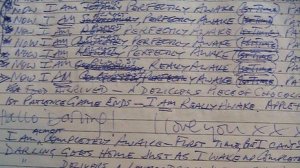Fairy tales are around us. Sometimes they are clad in witch’s hats, but nonetheless they exist. The case of Clive Wearing is one such fairytale.
Clive Wearing could have been known to the world as a conductor and musicologist, instead he is a familiar name in psychology textbooks as a man with the worst recorded case of amnesia.
The picture above represents his amnesic state better than words can. His memory loss (caused after a viral infection) is so severe that every few minutes he writes the line “Now I am awake”. When he realizes he wrote the same thing in the line above, he changes the previous line to “Now I am almost awake”. Sometimes he writes “Now I am really awake” in the new line. This continues in volumes of diaries he has kept over the years – a testimony to his ever renewing existence.
Now for the fairytale part. Clive Wearing, the man who cannot remember anything beyond the last two minutes, can recognize his wife and play music with utmost precision. Every time he meets his wife Deborah, he shows affection like a man meeting his love after many years. He tells her this is the first time he has seen a human being in years and he is glad to be with her. The same magic happens when he is seated at his piano. He can perfectly perform pieces, even make improvisations. To Clive, life is a void where music and Deborah are his only familiar comforts.
What is the neurobiological basis of this perplexing memory disorder? Our memory is divided into many categories. Episodic and Semantic are two such classes. Episodic memory is where we store our everyday memories like episodes of a TV show. Semantic memory is where we store facts. In other words, things we “remember” come from episodic memory whereas, things we “know” come from semantic memory. Generally speaking, memories are encoded as episodic first in the hippocampus, from where, after multiple reinforcements, it is stored in the prefrontal cortex as semantic memory. It is hypothesized that Clive Wearing’s episodic memory is completely obliterated while most parts of his semantic memory remains intact. The information that he had converted from episodic to semantic before his viral encephalitis remains unharmed. It is possible that his love for Deborah and for music was powerful and important enough to enter his semantic memory while most of his other memories perished.
His story has been told numerous times in scholarly and personal journals in fitting poignant tones. But when I read his story, I was struck by the romanticism. I wondered if his story can form a neurobiological definition of love. When a person enters our semantic memory is that when we fall in love with him/her? From that point onwards we don’t “remember” that one special gift, we “know” that the gifts we get from him or her are special.
_______________________________________
Here is an excerpt from Deborah Wearing’s book about Clive.
Another moving piece about Clive by the master science writer Dr. Oliver Sachs.



Sampurna..! I am touched. Thank u for sharing this beautiful story. The last lines will forever stay with me. 🙂
LikeLike
I am glad you liked it 🙂
LikeLike